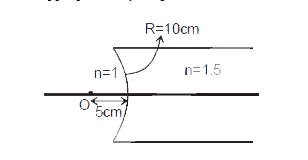Can you obtain the nature, position and relative size of images formed by a lens by drawing the ray diagrams ? If yes, draw neat ray diagrams to find different types of images formed by a convex lens.
We can easily obtain the nature, position and relative size of image formed by a lens by drawing the ray diagram using rays whose refracted path can be drawn easily.
A convex lens may form six different types of images depending upon the position of the object relative to the lens. Ray diagrams for these have been drawn in Figure.

Topper's Solved these Questions
- LIGHT - REFLECTION AND REFRACTION BOOK - U-LIKE SERIESCHAPTER - LIGHT - REFLECTION AND REFRACTION EXERCISE - SHORT ANSWER QUESTIONS
42 Videos
- ELECTRICITY BOOK - U-LIKE SERIESCHAPTER - ELECTRICITY EXERCISE - LONG ANSWER QUESTION
18 Videos
- MAGNETIC EFFECTS OF ELECTRIC CURRENT BOOK - U-LIKE SERIESCHAPTER - MAGNETIC EFFECTS OF ELECTRIC CURRENT EXERCISE - LONG ANSWER QUESTIONS
18 Videos
Similar Questions
Findout the position of the image formed and draw the appropriate ray diagram

View SolutionFindout the position of the image formed and draw the appropriate ray diagram

View SolutionDraw a ray diagram to show image formation by a concave lens.
View SolutionDraw ray diagrams showing the image formation by a concave lens when an object is placed
(a) between focus and twice the focal length of the lens
(b) beyond twice the focal length of the lens
View SolutionState the rules used for drawing ray diagrams for the fomation of an image by a convex lens .
View SolutionState the rules used for drawing ray diagrams for the fomation of an image by a convex lens .
View SolutionDraw a ray diagram to show the position and nature of the image formed in the above case.
View SolutionState the rules used fro drawing ray diagrams for the formation of an image by a concave lens.
View SolutionDraw ray diagrams to represent the nature, position and relative size of the lens for the object placed:
a) at 2F1,
b) between F1 and the optical center O of the lens.
Which of the above two cases shows the use of convex lens as a magnifying glass? Give reasons for your choice.
View Solution(i) Rohit claims to have obtained an image twice the size of the object with a concave lens. Is he correct? Give reason for your answer.
(ii) Where should an object be placed in case of a convex lens to form an image of same size as of the object? Show with the help of ray diagram, the position and nature of image formed?
(iii) With the help of ray diagram, illustrate the change in position, size and nature of image formed if convex lens in case of (ii) is replaced by a concave lens of same focal length.
View Solution
